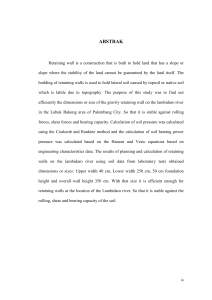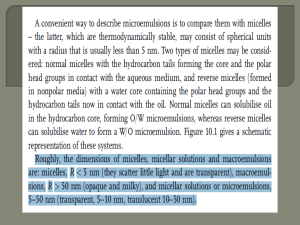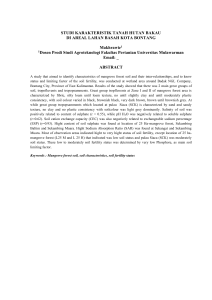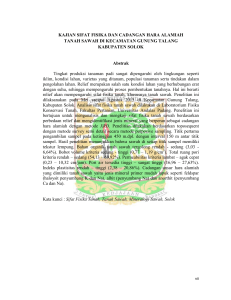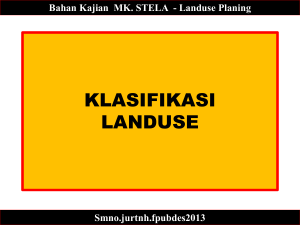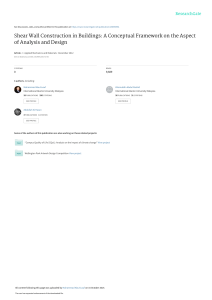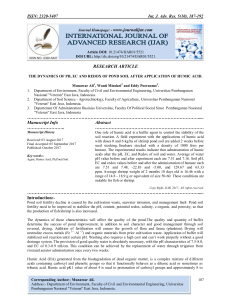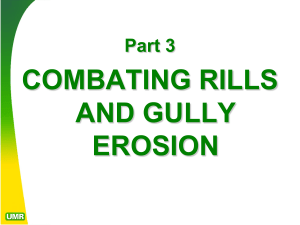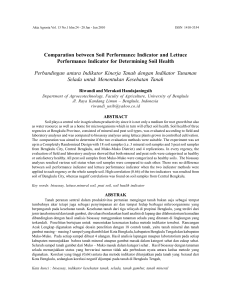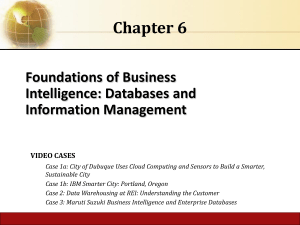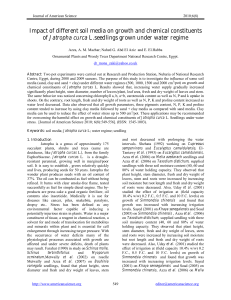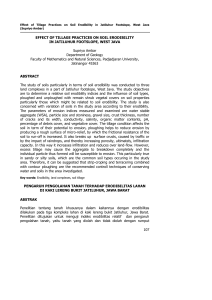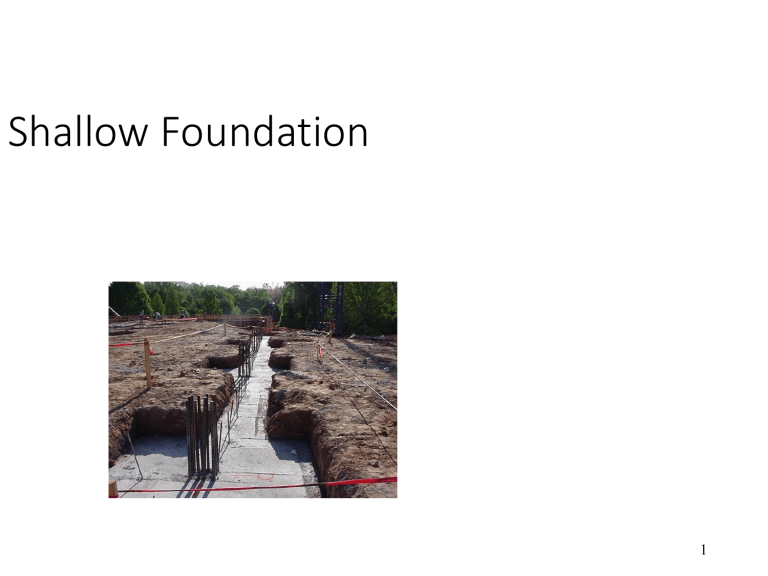
Shallow Foundation
1
Karl Terzaghi (1883-1963)
• Father of modern soil mechanics
• Born in Prague, Czechoslovakia
• Wrote “Erdbaumechanick” in 1925
• Taught at MIT (1925-1929)
• Taught at Harvard (1938 and after)
2
Content
1.
2.
3.
4.
5.
6.
7.
8.
Type of shallow Foundation
The need of SF
Bearing Capacity
Effect of GWT on B.C
Bearing Capacity from In situ test
Settlement
Stability
Reinforcement
3
TYPE OF SHALLOW FOUNDATIONS
• Spread Footing
• Continuous Footing
• Strap Footing
• Mat or Raft
Foundation
4
Shallow Foundations
• Shallow Foundations versus Deep Foundations
Foundations
Shallow
Foundations
Spread
Footings
Mat
Foundations
Deep
Foundations
Driven
Piles
Drilled
Shafts
Auger Cast
Piles
5
Shallow Foundations
• Usually the more economical option
• As a general rule, consider deep foundations only
when shallow foundations do not give satisfactory
design
• Types of Shallow foundations
•Spread footings (square, circular, rectangular)
•Combined Footings
•Continuous Footings
•Mat or Raft Foundations
6
7
8
Combined / Strap Footing
9
Construction Methods
• Excavation; Backhoe followed by handwork
oNeat footing-no formwork used
oFormed footing
10
Mat (or Raft) Foundation
11
12
DESIGN CRITERIA & DETERMINATION
•
Foundation must be designed to satisfy general criteria:
1.
2.
must be safe in terms of bearing capacity
must be safe from excessive settlement
13
DESIGN CRITERIA & DETERMINATION
•
Specific procedures for designing footings are
given in the following steps:
1. calculate the loads acting on the footing
2. obtain soil profiles along with pertinent field and
laboratory measurement and testing results
3. determine the depth and location of the footing
4. evaluate the bearing capacity of the supporting soil
14
DESIGN CRITERIA & DETERMINATION
5. determine size of the footing
6.
compute the footing contact pressure and check its stability against
sliding and overturning
7.
estimates the total and differential settlements
8.
design the footing structures / reinforcement
15
2. SAFETY FACTORS IN
FOUNDATION DESIGN
Why do we need Safety Factor for foundation design , and almost all
geotechnical case ?
1. To ensure our structure stable
2. Inability to use good mathematical model correctly
2. Uncertainty in sub soil information (method, equipments, labour
problems)
3. The possibility of Environmental change of building usage right
after construction or long time after construction.
4. Lack of info of sub soil parameters
q all
qult
FS
Calculating the allowable bearing capacity of shallow
foundations requires application of a factor of safety
16
(FS) to the gross ultimate bearing capacity
Factor of Safety
Depends on:
Type of soil
Level of Uncertainty in Soil Strength
Importance of structure and consequences of failure
Likelihood of design load occurrence
17
Accuracy; Bearing Capacity Analysis
18
Minimum Factor of Safety
Many Building code, states the value of SF
19
3. BEARING CAPACITY
1. Lab test
2. Insitu test
3. Load test
4. Empirical correlations
20
1. Lab test.
Types/Modes of Failure
• general shear failure
• local shear failure
• punching shear failure
21
Transcosna Grain Elevator Canada (Oct. 18,
1913)
22
West side of foundation sank 24-ft
Bearing Capacity Failure
23
1. General Shear Failure
24
Occurrence in dense sand or stiff clay
* The load - Settlement curve in case of footing resting on
surface of dense sand or stiff clays shows pronounced peak
& failure occurs at very small stain.
* A loaded base on such soils sinks or tilts suddenly in to the
ground showing a surface heave of adjoining soil
* The shearing strength is fully mobilized all along the slip
surface & hence failure planes are well defined.
* The failure occurs at very small vertical strains accompanied
by large lateral strains.
* ID > 65 ,N>35, Φ > 360, e < 0.55
25
2) Local Shear failure
Strip footing resting on surface
Load –settlement curve
Of Medium sand or Medium clay
* When load is equal to a certain value qu(1),
* The foundation movement is accompanied by sudden jerks.
* The failure surface gradually extend out wards from the foundation.
* The failure starts at localized spot beneath the foundation & migrates out
ward part by part gradually leading to ultimate failure.
* The shear strength of soil is not fully mobilized along planes & hence
failure planes are not defined clearly.
* The failure occurs at large vertical strain & very small lateral strains.
* ID = 15 to 65 , N=10 to 30 , Φ <30, e>0.75
26
3. Punching Shear Failure
27
* The loaded base sinks into soil like a punch.
* The failure surface do not extend up to the ground surface.
* No heave is observed.
* Large vertical strains are involved with practically no lateral
deformation.
* Failure planes are difficult to locate
28
BEARING
CAPACITY
THEORIES
PRANDTL
METHOD
(1920)
TERZAGHI
METHOD
(1943)
MEYERHOF
METHOD
(1963)
HANSEN
METHOD
(1970)
VESIC
MENTHOD
(1975)
Sequence of emerging Bearing capacity formula
29
Model Tests by Vesic (1973)
30
General Guidelines
• Footings in clays - general shear
• Footings in soft clays – local shear
• Footings in Dense sands (Dr > 67%)
-general shear
• Footings in Loose to Medium dense
(30%< Dr < 67%) - Local Shear
• Footings in Very Loose Sand (Dr < 30%)punching shear
31
Bearing Capacity Formulas
qult N c su zD
32
Terzaghi Bearing Capacity Formulas
33
Terzaghi Bearing Capacity Formulas
• DB
• No sliding between footing and soil
• soil: a homogeneous semi-infinite mass
• general shear failure
• footing is very rigid compared to soil
34
Terzaghi’s Bearing Capacity Analysis –
Terzaghi (1943) analysed a shallow continuous footing by making
some assumptions –
35
* The failure zones do not extend above the horizontal plane
passing through base of footing
* The failure occurs when the down ward pressure exerted
by loads on the soil adjoining the inclined surfaces on soil
wedge is equal to upward pressure.
* Downward forces are due to the load (=qu× B) & the
weight of soil wedge (1/4 γB2 tanØ)
* Upward forces are the vertical components of resultant
passive pressure (Pp) & the cohesion (c’) acting along the
inclined surfaces.
36
For equilibrium:
ΣFv = 0
(1/4) γ B2tan ø + quxB = 2Pp +2C ’ × Li sinø’
where Li = length of inclined surface CB; ( = B/2 /cosø’)
Therefore,
qu× B = 2Pp + BC ’ tanø’ - ¼ γ B2tanø’ –------ (1)
The resultant passive pressure (Pp) on the surface CB & CA
constitutes three components ie. (Pp)Y, (Pp)c & (Pp) q,
Thus,
Pp = (Pp)Y + (Pp)c + (Pp)q
37
qu× B= 2[ (Pp)Y +(Pp)c +(Pp)q ]+ Bc’tanø’-¼ γ B2 tanø’
Substituting; 2 (Pp)r - ¼rB2tanø1
= B × ½ γ BNY
2 (Pp)q
= B × γ D Nq
& 2 (Pp)c + Bc1 tanø1 = B × C1 Nc;
We get,
qu =C ’Nc + γ Df Nq + 0.5 γ B Nγ
This is Terzaghi’s Bearing capacity equation for determining
ultimate bearing capacity of strip footing. Where Nc, Nq & NY are
Terzaghi’s bearing capacity factors & depends on angle of shearing
resistance (ø)
38
ø
General Shear Failure
Local Shear Failure
Nc
Nq
Nr
Nc’
Nq’
Nr’
0
5.7
1.0
0.0
5.7
1.0
0.0
15
12.9
4.4
2.5
9.7
2.7
0.9
45
172.3
173.3
297.5
51.2
35.1
37.7
39
Important points :
* Terzaghi’s Bearing Capacity equation is applicable
for general shear failure.
* Terzaghi has suggested following empirical reduction to
actual c & ø in case of local shear failure
Mobilised cohesion Cm = 2/3 C
Mobilised angle of øm = tan –1 (⅔tanø)
Thus, Nc’,Nq’ & NY’ are B.C. factors for local shear failure
qu = CmNc’+ γ Df Nq’+ 0.5 γ B NY’
* Ultimate Bearing Capacity for square & Circular footing -Based on the
experimental results, Terzaghi’s suggested following equations for UBC –
Square footing qu = 1.2c’ Nc + γ Df Nq + 0.4 γ BNY
Circular footing qu = 1.2c1Nc + γ Df Nq + 0.3 γ BNY
40
General Terzaghi Formula
qult cN c S c zD N q S q 0.5 BN S
Table 1 Values for sγ and sc
Strip Footing
Round Footing
Square Footing
sc
1.0
1.3
1.3
sγ
1.0
0.6
0.8
41
Terzaghi Bearing Capacity Formulas
For Continuous foundations:
qult cN c zD N q 0.5 BN
For Square foundations:
qult 1.3cN c zD N q 0.4 BN
For Circular foundations:
qult 1.3cN c zD N q 0.3 BN
42
Terzaghi Bearing Capacity Factors
a2
Nq
2 cos 2 (45 / 2)
a exp (0.75 / 360) tan
Nc 5.7
Nq 1
Nc
tan
when 0
when 0
tan K p
N
1
2
2 cos 43
Bearing Capacity Factors
44
BEARING CAPACITY THEORIES OF TERZAGHI AND SKEMPTON
40
Nq
Nc
30
(degrees)
N
20
10
0
60
50
40
30
N q and N c
20
10
0
20
40
N
60
80
BEARING CAPACITY FACTORS [After Terzaghi and Peck (1948)]
Qf
q f = 1 B N + cN c + D f N q
2
45 footing
continuous
Meyerhoff formula
BC factors slightly different with Terzaghi
qult cN c S c d cic zD N q S q d q iq 0.5 BN S d i
Shape
For any
B
sc 1 0.2k p
L
sq = sγ = 1.0
For Ø = 0 o
For Ø ≥ 10
o
B
s q s 1 k p
L
Depth
D
d c 1 0.2 k p
B
dq = dγ = 1.0
D
d q d 1 0.1 k p
B
Inclination
ic i q 1 o
90
2
iγ = 1
i 1 o
90
2
46
Further Developments
• Skempton (1951)
• Meyerhof (1953)
• Brinch Hanson (1961)
• De Beer and Ladanyi (1961)
• Meyerhof (1963)
• Brinch Hanson (1970)
• Vesic (1973, 1975)
47
48
Vesic (1973, 1975) Formulas
qult cN c sc d cicbc g c zD N q sq d q iq bq g q 0.5 BN s d i b g
Shape factors….…
Depth Factors …….
Load Inclination Factors ….
Base Inclinations factors ..
Ground Inclination Factors….
Bearing Capacity Factors ….
49
Table 4: Shape and depth factors for use in either the
Hansen (1970) or Vesic (1973, 1975b) bearing-capacity
equations of Table 4-1. Use s’c, d’c when Ø = 0 only for
Hansen equations. Subscripts H and V for Hansen and
Vesic, respectively
: Inclination, ground, and base factors for the Hansen (1970)
equations. See Table 4-5c for equivalent Vesic equations 50
Inclination, ground, and base factors for the Vesic (1973, 1975b) bearing-capacity
equations. Refer to Figure 1.9 identification of terms.
51
Vesic Formula Shape Factors
B N q
sc 1
L
N
c
B
sq 1 tan
L
B
s 1 0.4
L
52
Vesic Formula Depth Factors
D
k tan
B
1
d c 1 0.4k
2
d q 1 2k tan (1 sin )
d 1
53
Selection of Soil Strength Parameters
Use Saturated Strength Parameters
Use Undrained Strength in clays (Su)
Use Drained Strength in sands,
Intermediate soils that where partially drained conditions exist,
c and
engineers have varying opinions; Undrained Strength can
be used
but it will be conservative!
54
4. GROUNDWATER TABLE EFFECT
55
Groundwater Table Effect;
Case I
1. Modify ′zD
2. Calculate ′ as follows:
b w
56
Groundwater Table Effect;
Case II
1. No change in ′zD
2. Calculate ′ as follows:
Dw D
B
w 1
57
Groundwater Table Effect;
Case III
1. No change in ′zD
2. No change in ′
58
5. B.C. FROM PLATE LOADING
TEST AND IN SITU TEST
Complete In situ test is on other slides
1. PLATE LOADING TEST
1. For tests in clays.
qu(f) = qu(p)
qu(f) = ultimate bearing capacity of the proposed foundation
qu(p) = ultimate bearing capacity of the test plate
2. For tests in sandy soils,
qu ( f )
Where:
BF
qu ( P )
BP
BF = width of the foundation
BP = width of the test Plate
59
60
The allowable bearing capacity of a foundation, based on
settlement considerations and for a given intensity of load, qo, is
1. for clayey soil
SF
BF
SP
BP
2. for sandy soil
SF
2 BF
S P
BP BF
61
2. IN SITU TEST
2.1 SPT
B < 1.22 m ; qall = 11.98 Ncorr x Fd x St/25.4 (kPa)
Fd= (1+0.33 D/B ) < 1.33
St = tolerable settlement = 25.4 mm (1 inch)
Ncorr = NField x CN
B>1.22 m ;
qall = 7.99 Ncorr {(3.28B+1)/3.28B}2 x Fd x St/25.4 (kPa)
62
2.2 CPT
• B < 1.22 m and allowable settlement = 25.4 mm
qall = qc / 15 ( kPa)
• B>1.22 m ; and allowable settlement = 25.4 mm
qall = qc / 25 {(3.28B+1)/3.28B}2
63
6. SETTLEMENT CRITERIA
Go to other slide
64
7. STABILITY CONTROL
1.
2.
3.
Vertical loading
Vert + Horizontal loading
Vert + H + Moment
65
1. V load only
V/A < qall
A=BxL
2. V + H
a). V/A < qall
b). (Cad A + V tanδ) / H > SFhor
3. V+H+M (eccentricity loading)
a) (Cad A + V tanδ) / H > SFhor
b) V / A’ + My/ I < qall
A’ = L x ( B – 2 e ) ; e = M / P
V / A’ - My/ I > 0
66
Simplified Pressure
Distribution
67
L
B
P
V/A’ + My/ I ?
M
V/A’
+
My/ I
=
68
Eccentric Loads or Moments
69
Eccentric Loads or Moments
70
8. Reinforcement
Under other subject
71
